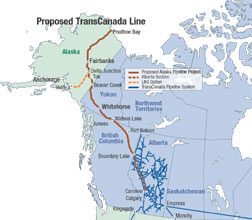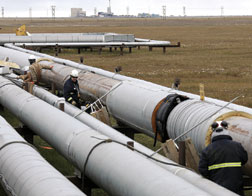TransCanada Corp. has won final approval from Alaska state legislators to build a natural-gas pipeline from the North Slope to Canada, where it would connect to a distribution system for markets in the contiguous United States. With costs estimated up to $30 billion, the gas line could be the largest capital project in North America in the coming years. But a competing plan by North Slope oil producers is raising concerns that TransCanada’s line may be starved of gas when both lines seek commitments from potential shippers.
| + click to enlarge |
 Transcanada
|
Alaska Gov. Sarah Palin (R) calls the approval of the license under the Alaska Gasline Inducement Act (AGIA) “a historic day in Alaska.” She says the next step is to “sit down with producers, TransCanada and with state officials—all who will be players—and start encouraging partnerships to be created.” It’s unclear how interested producers will be about a partnership.
On Aug. 1, Tony Palmer, TransCanada’s vice president for Alaska development, promised to quickly start the process of applying for a pipeline certificate from the U.S. Federal Energy Regulatory Commission (FERC).
The backing of the TransCanada plan is a triumph for Palin, whose administration put together AGIA after she took office less than two years ago. State officials have been talking about developing North Slope gas for years. A plan by Palin’s predecessor, Gov. Frank Murkowski (R), fell through when state lawmakers refused to vote on it, protesting that it handed over too much money to the oil companies.
TransCanada’s plan envisions a 48-in.-dia line capable of moving 4.5 billion
cu ft of natural gas daily that would run 1,715 miles from a treatment plant at Prudhoe Bay, Alaska, to central Alberta. There it would be integrated with TransCanada’s system to provide access to U.S. markets.
Leap of Faith
“AGIA is a leap of faith,” says Rebecca Braun, publisher of the Alaska Budget Report. She says it exposes the state to financial risk, including triple damages if terms of the act are violated. Two former Alaska governors publicly opposed the pipeline act.
 AP/WideWorld Natural gas is produced along with oil, but existing pipelines will not carry it.
|
The resource owners may be the biggest obstacle to the TransCanada line’s success. FERC approval is required before construction can begin, and regulators have said they would not let earth be moved for a project that lacked commitments for gas. But two companies that hold leases to North Slope fields, which would be tapped for natural gas, are developing a competing pipeline. This spring BP and ConocoPhillips announced Denali, Alaska Gas Pipeline LLC (ENR 4/28 p. 17). Denali officials say they would spend as much as $600 million in engineering and fieldwork by 2010, when the company plans to seek commitments from producers to ship gas in a process known as open season.
Some fear the producers will favor Denali over TransCanada’s line because they have no incentive to support TransCanada. State Rep. Beth Kerttula (D) believes the Denali project would not exist if TransCanada had not come forward with a plan under AGIA. The independent pipeline builder’s commitment gives the state leverage by proving the gas is not stranded.
Kerttula says if Denali fizzles out and producers still fail to commit their gas to the TransCanada project, there will be great pressure from U.S. consumers and Congress to force them to let it flow.

Post a comment to this article
Report Abusive Comment